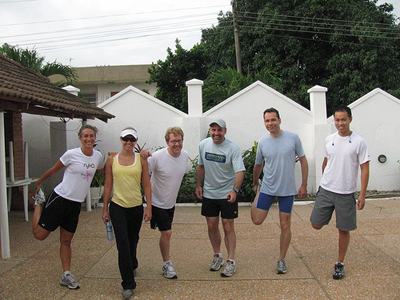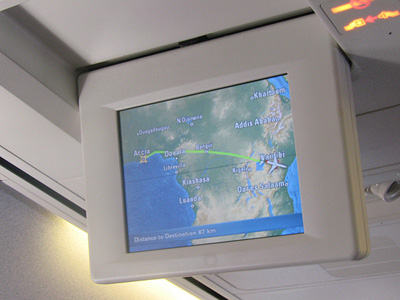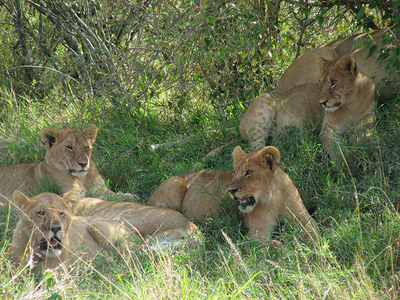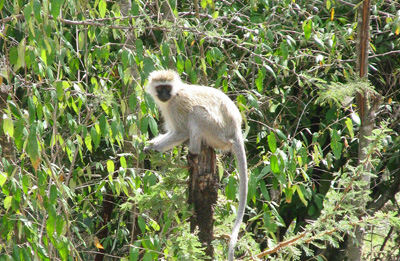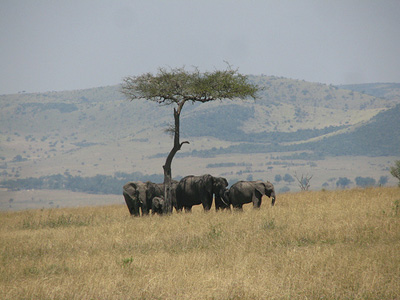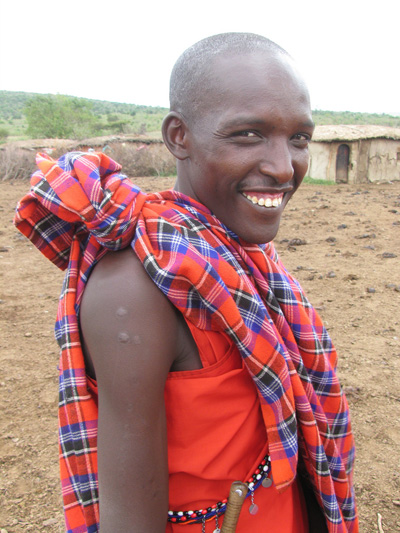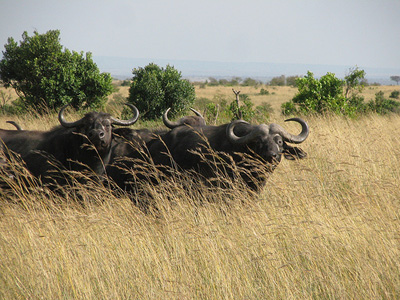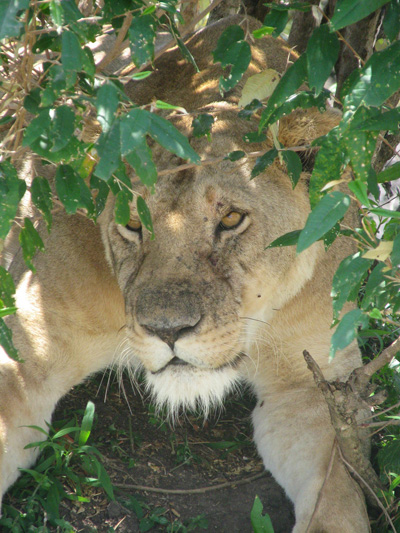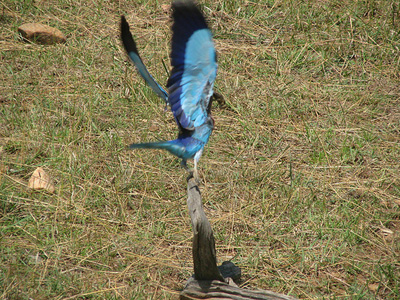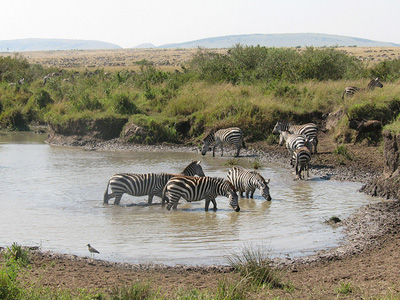An African Abecedarium
My son and I have finally finished a project that grew out of my photos from Africa this summer. It’s an abecedarium, a primer for learning one’s letters, using photos from Ghana and Kenya to illustrate.
Click here for a larger version of the slideshow. The pages themselves are fairly liberally licensed, so feel free to make of them what you like.
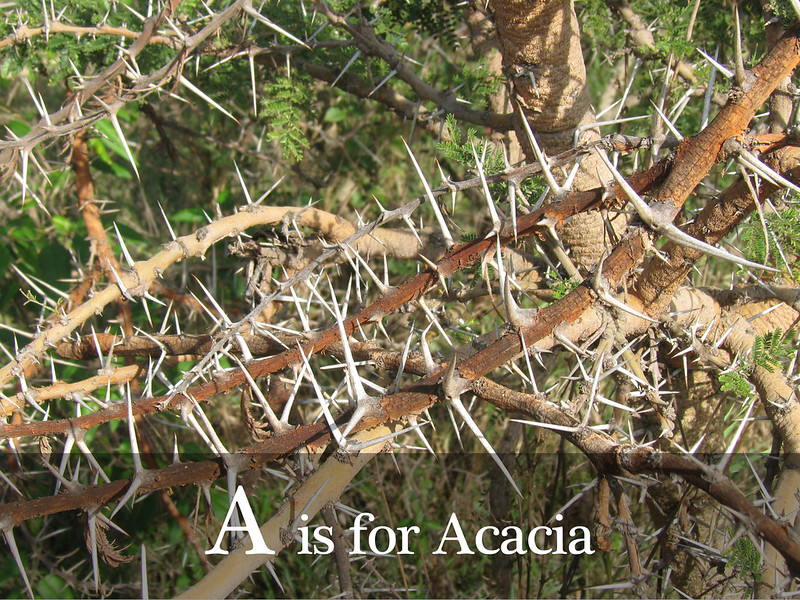
(You know, there really aren’t many words in English that start with “x” and that weren’t coined by ad agencies desperate to seem hip.)
But most of all, I missed YOU
I’ve been home from Africa just under a month. Thought I’d compile a list of things I miss and things I don’t.
Things I Miss:
- The Ghanaian handshake – Slap your hands together loudly (not a high five, just an aggressive bringing together of the hands for a normal handshake), hold until its a little awkward, then pull apart with a snap. I never quite got it and always felt horribly unhip trying to pull it off. But it was cool to be greeted like that.
- Laundered shoelaces – There was no laundromat nearby so we had some sketchy service that would come into our rooms and look for anything dirty. Before I figured this racket out they actually unlaced my running shoes (reddened by clay from dirt roads) and washed them separately. Anything for the upcharge, I suppose, though it was nice to have such gleaming white laces.
- Having taxis hail me – You never have to wave a cab down in Ghana, especially if you’re white. No matter where you are or how little you look like you need a ride, dozens of taxis will beep-beep beep-beep until you demonstrably tell them to go away.
- Saying “Ougadougou choo choo” – Ougadougou (wah·gah·DOO·goo) is the capital of Burkina Faso, the country to Ghana’s north. It is also the world capital with the most vowels in it. (Take that, Bosnia!) The nickname of the train service in and out of the capital is perhaps the most fun thing to say since I learned “trabajaba” in high school Spanish.
- Rear window car signage and business names – For reasons I still don’t completely understand Ghanaians are obsessed with naming their cars and shops with unintentionally humorous phrases from the bible. Or from something that sounds scriptural. Or not. “Be Holy Electrical Works”, “Dr. Jesus”, “I came naked”, “It wasn’t me”.
- Our prison economy – There were 10 of us at the guest house and we had only what we shlepped from home. Inevitably people forgot things and/or had items to swap. Though the Ghanaian markets offered lots of goods, there were certain things (meds, amenities, candy) that we had to barter amongst ourselves. It became a prison economy where mosquito wipes and vodka, rather than smokes, served as coins-of-the-realm.
- Dial-a-proverb – Emerson said “language is fossil poetry” which is a pretty accurate description of how laden the Twi language is with poeticisms and figures of speech. In fact, formal conversation consists of little but such turns of phrase. My interest in this characteristic of Twi became a game with my friend Yaw who would take any situation I gave him, call his pal who’s a master of Ghanaian proverbs, and come back with an appropriate phrase for the occasion.
Things I Do Not Miss:
- Restaurant service – No matter where we went, city or village, Italian, Chinese, Lebanese or Ghanaian, all meals took at least two hours. Even when we thought we were being sly by calling in our orders, the service was atrocious. We think this was because of limited staff and the fact that everything was made basically from scratch as soon as it was ordered. There were never enough menus to cover the table and food was never brought to us even near the same time. Often people were served thirty minutes after others. The food, however, was almost always exceptional.
- The Ghanaian noise for getting one’s attention – I understand that this is a perfect example of clashing cultural habits, but the staccato hiss that Ghanaian’s use to hail someone is just poison to Western ears. It sounds like a curse or worse, though admittedly it does get your attention.
- Lack of currency – Last year Ghana re-denominated its currency such that 10,000 old cedis would be equal to one new cedi. There were many reasons for this, but most signage has not caught up. That’s a surmountable, calculable inconvenience, but the reality is that no one ever has change. Hacking off four zeros means no one has the sub-cedi currency known as the pesewa. Merchants can’t break even small bills. I can’t tell you how many times I simply walked away either without the good I wanted or having given the merchant a sizable “tip”.
- Instant coffee – ’nuff said.
- Compact fluorescent bulbs – Don’t get me wrong. I’m all in favor of CFL’s, but Ghana has adopted them in a huge way. I don’t think I saw an incandescent the whole time I was there — which itself is fine, but CFL’s have indiscriminately and nakedly replaced every bulb everywhere. There’s nothing less comforting that a bright, uncovered fluorescent bulb. To make the switch, in my opinion, requires not just environmental consciousness but also some stylistic consideration.
- Racist South Africans – I met three white South Africans while I was in Ghana. The first was a racist drunk at a local Internet cafe who obsessively gambled online while smoking a hookah pipe. One night he was too drunk to realize that a shisha coal had fallen onto his laptop power supply. BOOM! It was like someone detonated a small firework. But he kept gambling on battery power. The second was a chatty guy at a hotel I was staying at in Accra. He would not take any hint that we did not want to talk to him at breakfast and insisted on letting us know his impressions of Ghanaians, this being his first visit. Let’s just say he used the word “savage” frequently. The third was a very pleasant, younger guy on his own on a business trip who made it clear that not all white South Africans harbor such deep-seated racism. I’m glad I met him.
- Dirt roads – My ass and nerves will never be the same. See the first part of this post.
- Diet Coke false advertising – Called Coke Light in Ghana, Diet Coke is obviously the focus of a massive marketing campaign. Billboards and signage are everywhere. And yet, no one ever has it in stock. It is a mythical elixir, something promoted but never distributed. My colleagues made fun of me for continuing to ask for it after a dozen failures, but by then it was a matter of principle.
- Under-table space management – We often ate out in relatively large groups. This required restaurants to push tables together. Inevitably seats would be placed right at the junction of two tables where no two legs could ever go. We saw this everywhere. It was almost as if the ability to arrange a table with chairs around it were more important than actually seating people there.
And yet, those cons are not nearly enough to make me not want to get back as soon as possible.
Tom bo li de say de moi ya, yeah Jambo Jumbo!
At the end of my assignment in Ghana I took a short safari on the Masai Mara in southern Kenya. It was extraordinary.
But it was hell to get to in every conceivable way. First we waited for seven hours in a cramped, hot hovel of a concourse while unspecified repairs were made on our plane. By the time we boarded at 4 AM we were too out-of-our-minds tired to care what possible repair could take that long and not require a full cancellation.
Arriving so late in Kenya we had to high-tail it out of Nairobi to make it to the Mara by nightfall. I didn’t realize why this was such an issue, until shortly after entering the Rift Valley and saying goodbye to any semblance of paved roads. Our driver/guide would have been maniacal in any vehicle, but the one we were in was particularly death-trappy. The speedometer did not work and yet every single warning light on the dash was a constant glowing red. I suspect the speedometer had been disconnected to get around a governor that the minivan supposedly had installed by the tourist commission.
Kenyans jocularly refer to the bumps of riding on pothole-ridden dirt at breakneck speed as “an African massage”. Which was funny for, perhaps, 100 yards. And then night came and the animals with it. It was exciting to see a herd of zebra in the middle of the road. Exciting for a second before realizing that my first experience with a wild animal might involve it coming through the windshield in a bloody heap. We actually rear-ended a wildebeest at one point.
Ah, but it was all worth it. The safari itself was a relatively last-minute, budget affair after our official assignment. Yet we were right in the middle of what’s known as the Great Migration when millions of animals (and their predators) move from the savanna of the Masai Mara in Kenya to the Serengeti in Tanzania.
You see so many animals in such a natural state in such a small amount of time that you start to think it normal, say, to have a group of monkeys invade your tent and steal your food. (Which they did, the little bastards.) But then you realize it is normal. Humans are just used to zoos, and National Geographic, and urban life (mostly) devoid of wild game.
We saw zebra, impala, baboons, huge rabbits, bat-eared fox, grasscutters, wildebeest, Topi antelope, elephants, giraffe, vultures, hyland cattle, African buffalo, the rare black rhino, the secretary bird, vervet monkeys, Thompson’s gazelles, warthogs, ostriches, lions, hippos, mongooses, hyena, Marabou stork, eagles, guinea fowl, and one very elusive leopard.
Here are some glimpses from the full set of photos and video.
And now, the payoff. “Hello” in Swahili, the main language spoken in Kenya, is “Jambo!” which is a hell of a lot of fun to say. And it’s even more fun to say when you realize that it is what Lionel Richie was actually saying while rocking out during All Night Long. I can’t seem to find a translation of the full line (in this post’s title) so in the meanwhile, do yourself a favor and watch the video.
Africa is a way of thinking
I came to some startlingly common sense realizations while in Africa. For instance, its now clear to me that sustainable environment practices and Africa are inextricably linked. They aren’t separate matters or concerns or causes. To act on one is to act on the other.
Here’s the obvious part. Africa — and the entire “Global South,” as it is often called — stands to lose the most from planet-wide environmental deterioration. The fate of Africa has always firstly been tied to the environment. Even when you subtract out all the man-made horrors that Africa has seen life on the continent is shaped in deep ways by the ecological, geological, and meteorological hand it has been dealt. Subsistence agriculture, wars over limited (or precious) resources, lack of access to coasts, the range of the tsetse fly — all these things define life more immediately than the environment does (for now) in other places.
But there was insight too. A lesson, you could say, that the first world can learn from the third. Sustainability is a way of life for Africans. They don’t think about it as such. It isn’t a campaign or a movement like it has become in the West, but it is evident everywhere, woven into everything Africans do.
Simply put, Africans live with resource scarcity. They have not experienced consumption out of whack with production because it has never been a possibility.
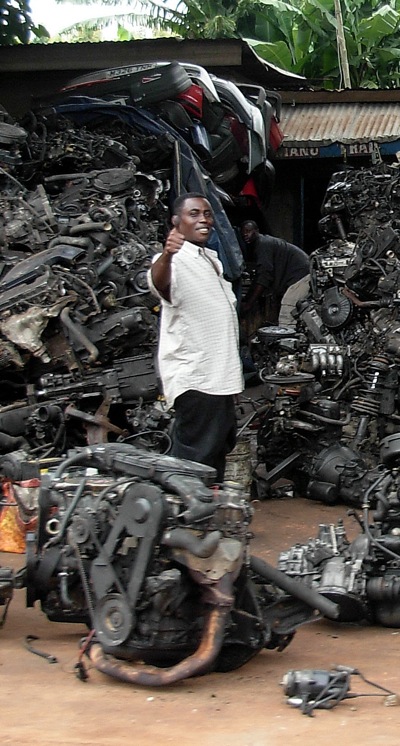
For every place you see selling cars you see five places recycling every possible component of the cars. Usually its for repair, sometimes it is to create something utterly different.
Or take tro-tros, the ubiquitous, horn-happy minivans that criss-cross every part of Ghana moving people more efficiently than a bus system every could. It’s a totally decentralized, mostly private group taxi service. Mass transit on an unbelievable scale with no set routes at all. Need a ride? Flag a tro-tro. You’ll get where you’re going. (Not unlike hailing a “taxi” in Russia, though there rides are less frequent, less capacious.) While tro-tros are almost universally decrepit, smoke-belching buckets of bolts, the system as a whole is by far more environmentally friendly than private cars or even a fleet of taxis.
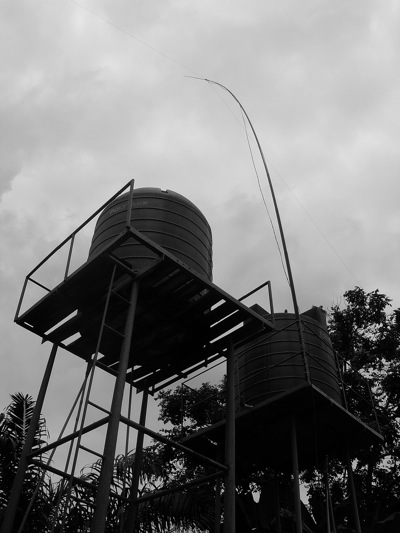
One fact of life in Ghana is the unreliability of centralized services. The electricity grid, for example, cuts out a few times every week. Just … off. Usually mid-day when it is hottest out. Yet this is not nearly as disruptive as it would be in the West. Partially this is just an attitude of resignation; that’s just the way it is. But because it’s the norm most places simply do it themselves with generators on standby (or have ways of manually doing what would otherwise be electrically-powered).
There’s no central water supply either so in urban areas private gravity tanks (or nearby streams) provide running water. The explosive growth of mobile phones is in part fueled by a lack of reliance on a centralized grid of services. It’s obviously not industrial age mega-infrastructure but more like modular, emergent services — build as you go, bottom-up. Like the Internet itself, basic services are built to work around outages.
To a Westerner this seems like privation but, looked at another way, it is a built-in constraint on excess usage. Self-sufficiency isn’t radical; it’s practical. And self-sufficiency naturally requires an intimate knowledge of one’s own patterns of consumption. You use what you have and nothing more. It ain’t rocket science.

So why is this a lesson? Certainly I’m not claiming that open sewers or power outages are the way forward. Nor should it be taken to mean that Africans are somehow immune to over-exploitation of resources.
Yet, Africa provides an example of what a society might look like that has so totally internalized sustainable living that it informs everything it does. Africa as a behavioral template, not a developmental one.
There are many paths that lead to this way of living within one’s means. You can choose to do it or you can be forced to because all your other options have been exhausted. Most of Africa has no other choice.
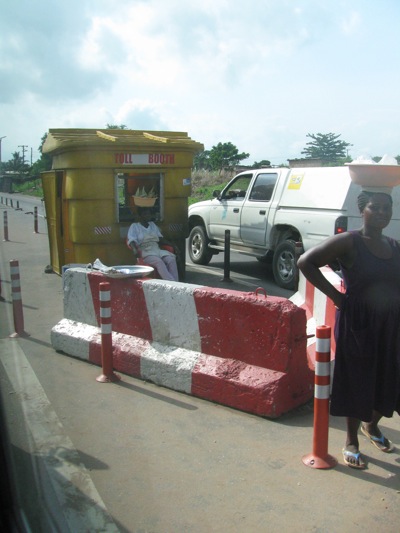
It took me a while to realize how pragmatic the idiosyncrasies of daily life are in Ghana. After first I thought the army of vendors on the road was a nuisance. They’re not “roadside” but in the middle of the road, often long lines of people selling the exact same thing — tissues, water, power strips, mangos, anything. (Even the mayor wants them off the road.)
But actually it makes a ton of sense because traffic is often such a mess. It’s like one huge drive-through mall. In the lingo of a typical consultant: they’ve monetized gridlock. It’s efficient and practical, such as at the toll stop pictured above. I’m not arguing for in-road vending so much as noting that what seems crude is often entirely sensible, bordering on ingenious.
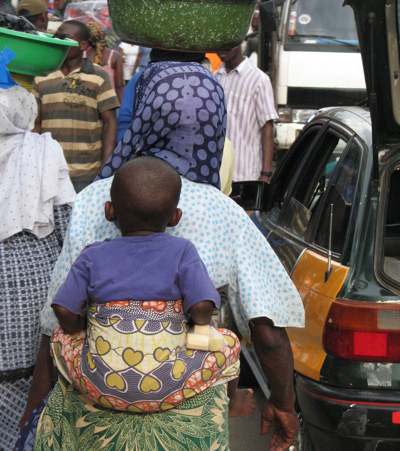
It’s hard for non-Ghanaians not to do a double-take when they see women carrying staggering loads on their heads, but once the shock wears off you realize, wow, that really is efficient. The arms are free to do other things while the entire frame of the body distributes the load atop the spinal column. Also, it makes for good posture.
But the most practical form of carriage is the way babies are swaddled. Just a single sheet wrapped around the child who’s straddling the mother’s back and literally sitting atop her butt. I never once saw a child squirming or screaming and the moms looked similarly non-plussed. Again, the arms are free to do whatever.
What do baby swaddling and sustainable living have to do with one another? They’re both examples of deep-rooted pragmatism. It seems simple, even backwards sometimes, but the way of life I saw both in Ghana and Kenya was firstly about solving everyday problems. It’s largely coincidental that many of these problems are matters of production and consumption — the very basis on our misaligned relationship with the planet.
Let’s take some inspiration from Africa. It’s a plentiful, renewable resource, after all.
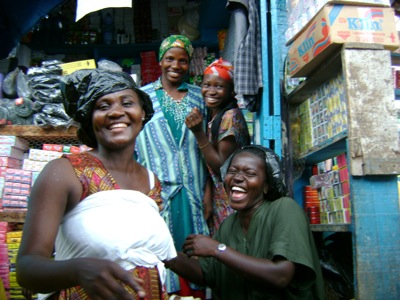
Rocks and hard places
In Ghana I took a trip with Margaret to her mother’s home village of Tanoboase (tah·no·bo·AH·say). It’s dirt poor, centered around the local voodoo shrine, and governed by a chief — in other words, a microcosm of what makes Ghana unique, world’s away from the urban centers of Kumasi and Accra.
Tanoboase is a good example of a town that would seem to be able to pull itself up a level. It is on the main artery from Kumasi to Tamale and it stewards a stunning historical-natural eco-tourism project. It’s close to the Boabeng-Fiema nature sanctuary (teeming with monkeys treated as children of the local gods) and it is near an amazing set of waterfalls.
And yet, Tano (as it is called) hasn’t been able to capitalize on the tourist dollars that overflow to similar areas near the slave sites of Cape Coast.

Boase means ‘under the rocks’ and the landscape up in this region is forest punctuated by crazily-shaped summits popping out from the trees. The form of the rock — caves, natural bridges, smoothed planes, boulders balancing on points — suggests some powerfully-erosive water flow through here eons ago.
This all makes for arresting views so it wasn’t a surprise to learn that there’s a Catholic (Benedictine, to be precise) monastery nestled into a nook. Kristo Boase is a quiet little operation of only about a dozen men (a convent is slated to open next year). Mostly it is prayer and agriculture in a secluded, inspirational setting. The monks don’t observe silence but the place is supernaturally silent. You’re as likely to hear a monkey screech as anything else.
One especially interesting point for me was a visit to the monastery’s cashew orchard. I’ve written previously about the fascinating biology of the blister nut, so imagine my delight at being able to see acres of them on the tree. They don’t just eat the cashews — no, this is a Catholic monastery: they distill the nuts into a potent liquor.
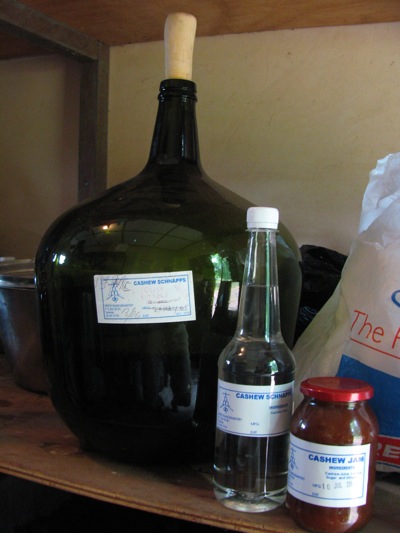
It’s cashew schnapps. And it is odious. But I bought a bottle, as well as cashew jam. I’m a supporter of the blister nut.
From Kristo Boase we headed a short distance into the town of Tano — and by town I mean about a half mile of variously-dilapidated structures hugging the Tamale road. This was Margaret’s true homecoming. She had not been back to visit in 25 years, but before we were all out of the car family came running up to greet.

Margaret’s aunt herded us around from villager to villager. I couldn’t keep track of who was related and who wasn’t — but then, maybe that wasn’t even a distinction anyone made. It was as if the Chicagoan Margaret had just been up the road at the next village for a while.
Lots of furious chatting in Twi, lots of stares, but no one at all visibly perplexed at my radiant alabaster skin. I was with Margaret.
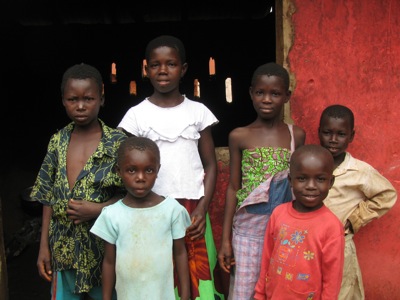
Tano’s two claims to fame — and sources of tourism, such as it exists — are the local voodoo shrine and the sacred grove, closely connected to one another. The shrine is an odd thing. It houses a dark room and a tabernacle-type bowl said to contain Taakora, head of the Akan nature gods. It’s run by a fetish priest and you’re allowed in for a small fee. Margaret would have none of it and insisted on staying outside the “evil” place. I had to go in, of course. Honestly I couldn’t see much — it was deliberately creepy and shadowy.
It’s remarkable how seemingly unfazed Ghanaians are by their overt, omnipresent displays of Christianity and their reverence for hyperlocal animist gods. Something like 70% of Ghanaians are Christian, with the remainder Muslim. Yet nearly all villages have some sort of local spirit who receives supplication and is the threat behind frequent curses being placed on people.
Margaret’s brother was cursed by a villager years ago for a perceived slight. Her family — singularly Christian — took no heed. Her brother later had surgery on his throat for some ailment that the villagers all took as proof of the fulfillment of the curse. Rather circular logic, but there it is. The simple fact is that most Ghanaians pray to a Christian God while respecting what they call “small gods.”
As is customary when visitors come to town we met with the local chief, the Tanoboasehene. He remembered Margaret too and even gave her a hug, which was odd since protocol requires you to speak to the chief through his assistant. Hugs apparently do not contradict the prohibition against addressing the chief directly.
Also a matter of custom is presenting the chief with a bottle of liquor, usually schnapps. (Hey hey, the blister nut saves the day!) A small quantity is then poured on the ground in remembrance of villagers past. Yes, this is precisely where the African-American “tradition” of “pouring one out for my homies” originated. You won’t be surprised to learn that in Tano it was done a bit more reverentially than in America.
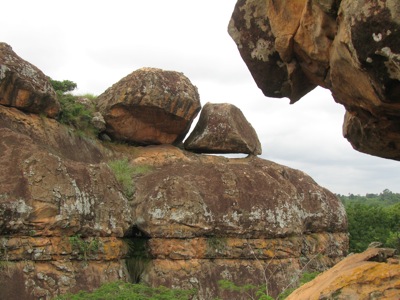
From the shrine you depart for the Tano Sacred Grove, the real home of Taakora as well as the site of the origin myth of the local Bono people. It is also the location of a last stand of local Akan during the tribal wars and slave raiding of 17th century.
The grove is certainly treated as sacred. Everything in it is protected (hence its eco-tourism designation) and there is a vaguely temple-like atmosphere walking in the semi-darkness of the vegetation and overhanging rocks. There’s myth and ritual at every turn. (Apparently virgins who enter the grove to fetch water will go blind.) It can be plain eerie.
Once you make it up the rocks and peer out across the tops of trees you realize that, religious or not, it is a rightful source of pride for the locals.
Margaret of course wanted to know what I made of all of it. She wanted to know how we could help jumpstart tourism, anything to help. I’m not an expert on tourism of course, much less rural African economic development, but it seems to me the problem is basically infrastructural. Getting to Tano is a chore, if not downright risky.
The “main artery” is barely paved and has lots of lethally-overloaded trucks traveling at incomprehensible speeds. Most tourists hug the coast, visiting Elmina, Cape Coast, and possible Kakum National Park. But there is a subset that ventures into the Ashanti inland empire and this would be Tano’s target group — if only they could get there.
The problem is the road. Open up the bandwidth and good things can happen. It’s the network economy of the industrial age: connectivity doesn’t just move stuff about, it multiplies the value of stuff. Without dependable physical access Tano can’t participate in the economic revitalization of the rest of the country.
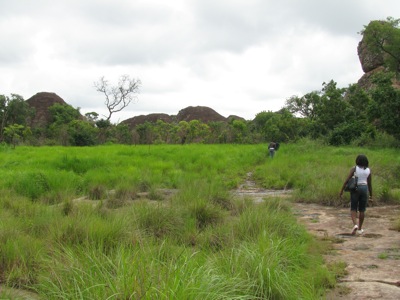
But Tano isn’t going anywhere. Like most villages cut off from the grid of urban services, they’re largely self-sufficient. And the Sacred Grove is obviously enduring and legally protected to stay that way. The road will come.
Call of the wild
In Kenya I stayed in a tent camp — not at all a luxury and a great way to extend the daytime safari thrill of being surrounded by animals. It was a thrill mostly unseen as the night came alive with noises that were always just outside the radius of the feeble gas lanterns around the camp.
Maasai tribesmen, hired by camp, patrolled the grounds at night, but it was still unnerving. Perhaps even more so when I’d start to wonder why we needed guards in the first place.
Cracking branches, rustling in the brush, and occasional screeches in the distance — it all made getting up to take a leak outside the tent at night positively terrifying. In fact the night before I arrived a lion came into camp at night and roared for about twenty minutes. The Maasai said it was just “talking” to its pride.

Coincidentally I had been reading a fascinating survey of 20th century music that mentioned in passing a study by two psychologists exploring the reason that certain musical passages give people the chills.
Their theory? It’s related to the call of the wild, which also explains the feeling of hearing an animal cry in the distance in a dark tent.
In our estimation, a high-pitched sustained crescendo, a sustained note of grief sung by a soprano or played on a violin (capable of piercing the ‘soul’ so to speak) seems to be an ideal stimulus for evoking chills. A solo instrument, like a trumpet or cello, emerging suddenly from a softer orchestral background is especially evocative.
Accordingly, we have entertained the possibility that chills arise substantially from feelings triggered by sad music that contains acoustic properties similar to the separation call of young animals, the primal cry of despair to signal caretakers to exhibit social care and attention. Perhaps musically evoked chills represent a natural resonance of our brain separation-distress systems which helps mediate the emotional impact of social loss.
Put another way, a solo instrument breaking free from the larger family of sound evokes in humans a kind of separation anxiety, an empathetic response that, like separation, is largely fear-based. And this response, the authors posit, is evolutionary. It’s related to animals (or human babies) calling out for attention. The call of the wild is a call of isolation. And isolation is scary.
They continue, attempting to explain the chills further.
In part, musically induced chills may derive their affective impact from primitive homeostatic thermal responses, aroused by the perception of separation, that provided motivational urgency for social-reunion responses. In other words, when we are lost, we feel cold, not simply physically but also perhaps neuro-symbolically as a consequence of the social loss.
“Homeostatic thermal responses” … yes, a hug. Chills as symbolic response to a lack of skin contact with others of your group. (Consider this image of a monkey baby clung to the bottom of its mother.)
See also a podcast from today’s Guardian on related evolutionary insights from music.
The Gold Coast
Our work in Ghana is finished, though the projects themselves are just begun.
I think we’ve made some difference with Aid to Artisans. They now have a very comprehensive analysis of their producers’ chain of supply from raw material to end consumer, video documentation of same, a set of recommendations on revamping their website including a redesign, and a roadmap for e-commerce. I’m pleased.
I’m also exhausted, and dirty, and homesick. But there’s one last adventure. I’m headed to Kenya tomorrow for a four-day safari on the Masai Mara, edge of the Serengeti. It’s a tent trek: no electricity, running water, or (can you believe it?) net access. Leaving all my gadgets in Accra. Offline, gridless, naked.
I have so much more to write about Ghana. Amazing fishing villages, a visit to a voodoo shrine, and playing in a tennis tournament as the only obruni. But it’ll all have to wait.
Thanks for reading this past month. Back in the fold after the safari!
(Full photo and video set is here, if you’re interested.)
Brass
Part six (of six) of the Ghanaian Handicraft series.
I’ve left the most complex handicraft until the end. I’m ashamed to admit how long it actually took me to figure out just what the heck was going on. A metallurgist, I’m not. But it is also arguably the coolest craft I learned. Here’s why.
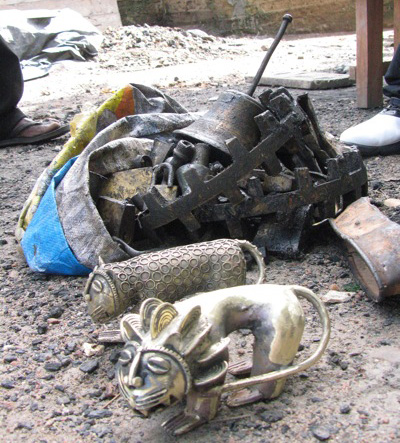
Brass artisans take take the trash of technology — gears, circuit boards, wires, pipes — and transform it into art. It seems so right — such a fitting way to repurpose what otherwise would be non-biodegradable and in some instances toxic. (Glass bead artisans do something similar with discarded bottles.)
Specifically brass workers strip zinc and copper where it can be found and, though the level of impurity is high, they’re able to forage quite a bit.
But let’s back up. Making brass is relatively easy compared to getting it into the shape you want. Basically the art in this craft is all about the mold. It starts with long strings of honeybee wax. How the wax is shaped is exactly how the envisioned product will look. That is, where wax is in your model is where the liquid brass will harden. So get it right.
Charcoal is the material around which or through which you place the wax. It holds things in place. So, as in the video above let’s say you are making hollow, decorative spheres (for a necklace, for instance). A charcoal ball at the middle supports the wax decoration which will eventually becomes the brass.
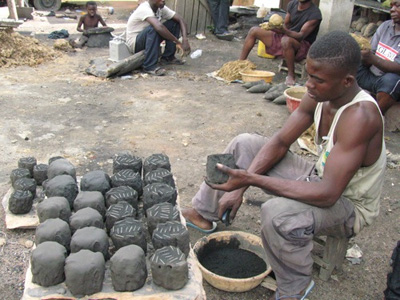
OK, follow me on this. It hurts the brain a bit. Charcoal is packed around the finished wax model too. So basically you have the shape of the final product, in wax, completely surrounded by charcoal. Then this is all encased in a mud and straw crucible.
The key to it all is that there is no wax isolated completely inside the crucible. It all touches some other wax and is finally connected to strands of wax that poke out of the charcoal. See where this is going?

The crucibles are heated around a fire and the wax melts. It is drained out — thanks to nothing being isolated and the “channels” of wax that stick out of the mold. What you have is a perfect inverse mold of what you’re trying to make. Just pour in the brass (melted obviously) and let it set. Chip away the charcoal and voila! Brass from trash.

More brass-making video here.
Sally Struthers go home
Been struggling with how to put into words something I’ve felt visiting the poorer areas of Ghana.
Like most Westerners my concept of poverty in Africa is heavily informed by aid campaign advertisements. (I blame Sally Struthers completely.) Pre-programmed, one just sort of expects to find misery and unhappiness: sobbing, curled children with distended bellies; emaciated frowns from doorways; a total lack of joy.
I have seen none of this. In fact, if there’s any emotion I see more frequently than others it is happiness.
Now, before you say that I have confined myself to upscale, urban areas, I’ll note that most of the first two weeks’ work was in the field in tiny villages without electricity, running water, or any infrastructure whatsoever.
Certainly there is much misery and want in Africa. Failed states, pestilence, warfare — take your pick. But the longer I am in Africa the more I realize that we’ve been conditioned to believe that Africans are not happy. Purely from a aid organization sales perspective this makes sense: if people are happy with their plight in Africa why send your support check in?
It comes down to this: standard of living is not the same thing as quality of life. Would Ghanaians love to have other amenities that first-world citizens enjoy? Perhaps. Are they in abject misery because they do not? No way.
In thinking that Ghanaians’ quality of life suffers because their standard of living is below ours we’re making a cliched blunder, guessing at the perspective of someone else through the filter of your own cultural sensibilities. It’s arrogant. And demonstrably incorrect.
Africa could use help, there’s no doubt. But aid will never be effective if we provide it based on caricatures of behavior meant to tug at us emotionally. So, Sally, go home. I know children lack food and die of horrible illnesses in Africa. But images like that mask the real complexity of the needs and promise of African society. Let’s be more honest.
Clay
Part five of the Ghanaian Handicraft series.
As in many cultures, pottery is made from clay in Ghana. Yet as a craft it is hard to find here, largely because it is considered utilitarian, with a market that’s almost completely domestic. People use the pots, bowls, and vessels in everyday life.

Unlike other handicraft that is created at some distance from the source of the raw materials, potting happens close to the river banks that provide the clay, presumably because it’s a pain to move large quantities of the dense, wet material.
We visited the tiny village of Nfensi and were taken to their river. It was one of those glad-I-took-my-malaria-meds moments. (Luckily we were there during the daytime, before the virus-toting Anopheles skeeters come out.)
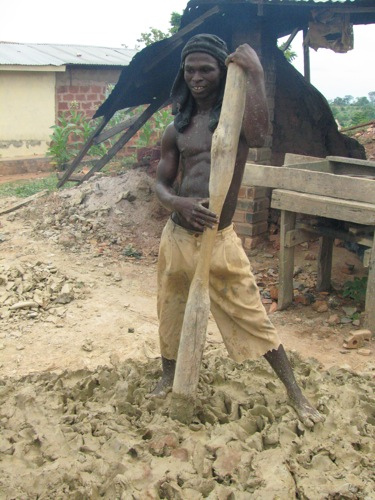
Once hauled up from the water the clay is pounded repeatedly to loosen it up. (The pounder uses the same tool that smashes open yam and cassava for fufu, incidentally.) There’s a further step of kneeding, then the potter slices off as much clay as he’ll need and slaps it on the wheel.
The potter’s wheel is completely manual. One guy cranks it while the master shapes the clay.
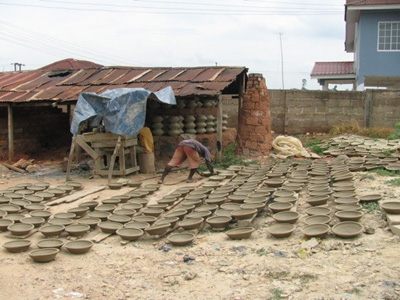
It happens so quickly and effortlessly — probably not surprising given that they turn out approximately 1,000 items every three days.
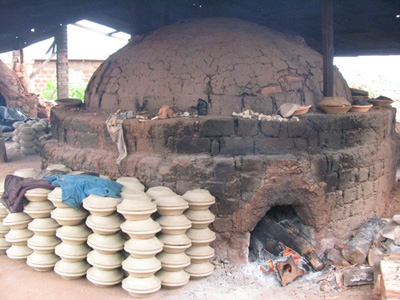
Once dried, the clay objects are prepared for the igloo-shaped kiln. It’s infernally hot around the oven which the artisans actually walk into to stack the clay pots. Then the “door” to the oven is bricked up and the fire is allowed to go for a few days. The door gets broken back down and out come the finished, though unadorned pieces.
There is an export market that consumes larger, more finely decorated pieces, but it is overshadowed by the more “traditional” wooden export market. To many Westerners, Africa means wood carvings (masks, statues, etc). But those consumers who are interested in owning the most “real” African goods — what one study calls “authenticity buyers” — might look to pottery as an alternative.
More clay pottery video here.

